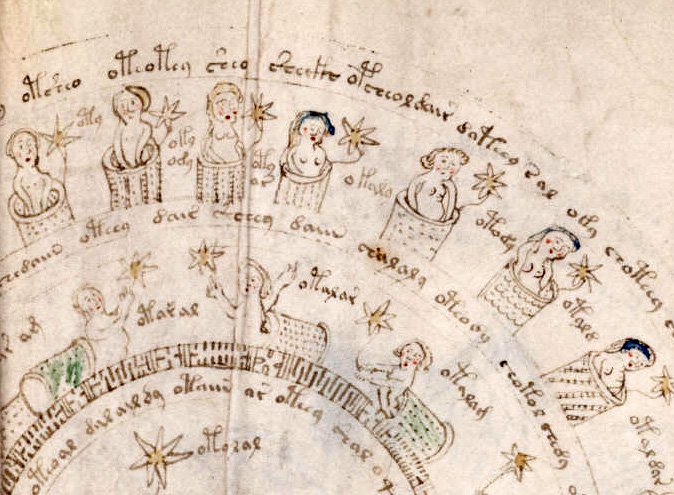The Voynich Manuscript—- Solved?
by wjw on September 9, 2017
 My introduction to the Voynich Manuscript came in the Chaosium RPG Call of Cthulhu, in which it was presented as an item that could (1) increase your knowledge of the occult, while (2) blasting your sanity. Oops!
My introduction to the Voynich Manuscript came in the Chaosium RPG Call of Cthulhu, in which it was presented as an item that could (1) increase your knowledge of the occult, while (2) blasting your sanity. Oops!
Despite its appearance in an RPG and the works of Lovecraft, Colin Wilson, and others, the Voynich Manuscript is a real thing, an early 15th Century handwritten manuscript, profusely illustrated by several several different unknown artists. The text is in an unknown script, widely assumed to be a cypher, and the illustrations are of bewildering variety, including detailed botanical drawings, some of plants that do not seem to exist in nature, along with astronomical imagery, and others drawings assumed to be of occult or symbolic nature.
Various solutions have been offered over the years, including theories that the manuscript is Roger Bacon’s lab notes; that the text is vowelless Ukrainian; or a description of a Cathar rite; that the whole thing is a forgery meant to impress Emperor Rudolf II; and (from a Finnish character who calls himself “a Prophet of God”) that the characters describe “sonic waves and vocal syllables,” and can’t be deciphered without divine assistance.
So varied are the various claims and counter-claims that you might sensibly conclude that the Voynich Manuscript is, as in Call of Cthulhu, a threat to your sanity.
Now TV writer Nicholas Gibbs has offered his own solution, claiming that the manuscript is a health manual for upper-class women, or perhaps for a single upper-class woman. According to Gibbs, the manuscript offers herbal and magnetic cures (often in the form of baths), along with astrology (medieval cures were often tied to the patient’s horoscope).
(Note the illustration above, showing a row of bathing ladies each of whom is tethered to a star.)
The cures themselves, according to Gibbs, are largely plagiarized from medieval medical texts like Tratula, De Balneis Puteolanis, and Herbarium Apuleius Platonicus, which themselves are largely plagiarized from Galen, Hippocrates, and Soranus, who themselves plagiarized their cures and simples from earlier writers. (It’s plagiarism all the way down, so to speak.)
 And the mysterious ciphered writing? According to Gibbs, they aren’t an alphabet, but “ligatures,” common in handwritten medieval manuscripts, in which a single glyph is shorthand for an entire word. An example would be the ampersand, &, which is a ligature standing for “et,” the latin word for “and.”
And the mysterious ciphered writing? According to Gibbs, they aren’t an alphabet, but “ligatures,” common in handwritten medieval manuscripts, in which a single glyph is shorthand for an entire word. An example would be the ampersand, &, which is a ligature standing for “et,” the latin word for “and.”
Other ligatures surviving into the modern era would include Œ, Æ, and the ẞ symbol used in German for “ss,” as in “Straẞe” or “Groẞe.”
Gibbs says that much of the confusion has arisen because of a missing index page, in which the ligatures would have been explained and the plant illustrations identified.
So how seriously are we to take this? Gibbs is a TV writer whose previous works are manuals for writing for TV, and he has no credentials as a medievalist that he cares to offer, other than as “someone with long experience of interpreting the Latin inscriptions on classical monuments and the tombs and brasses in English parish churches.” He seems to view his method decoding the manuscript as self-evident to anyone with his particular skill-set. His method seems to consist of connecting the dots, as in the following:
In the Voynich manuscript, the same object – an oversized doughnut with a hole and a carbuncle attached to its side – is proffered by several of the unclothed women. Its significance only became apparent when, as I was casually leafing through a medical-related book, Ortis Sanitatis (1482), its pages overflowing with woodcuts, I came across the doughnut object depicted as a lodestone (natural magnet). Passages in the versions of the Trotula, Galen, Hippocrates and Paulus Aegineta advocate a lodestone as part remedy for gynaeocological complaints in the same region of the body as the figures demonstrate in the Voynich manuscript.
Not being much of an expert myself (except maybe in Call of Cthulhu), and never having “casually leafed” through a medieval medical text, I have no way of evaluating this alleged discovery, but I think I can safely predict that I will enjoy the various screams, mutterings, and tut-tuttings soon to emanate from classicists and from other Voynich enthusiasts.
Ad agusta per angusta, y’all.
Previous post: Kiss of Fire
Next post: Criminals?
 My introduction to the Voynich Manuscript came in the Chaosium RPG Call of Cthulhu, in which it was presented as an item that could (1) increase your knowledge of the occult, while (2) blasting your sanity. Oops!
My introduction to the Voynich Manuscript came in the Chaosium RPG Call of Cthulhu, in which it was presented as an item that could (1) increase your knowledge of the occult, while (2) blasting your sanity. Oops! And the mysterious ciphered writing? According to Gibbs, they aren’t an alphabet, but “ligatures,” common in handwritten medieval manuscripts, in which a single glyph is shorthand for an entire word. An example would be the ampersand, &, which is a ligature standing for “et,” the latin word for “and.”
And the mysterious ciphered writing? According to Gibbs, they aren’t an alphabet, but “ligatures,” common in handwritten medieval manuscripts, in which a single glyph is shorthand for an entire word. An example would be the ampersand, &, which is a ligature standing for “et,” the latin word for “and.”
Interesting. It sounds plausible.
The virtue of this is that it actually makes sense and home made stenography is a simpler explanation than the complicated ones our brains seem to want to make up.
Nonsense!
Comments on this entry are closed.